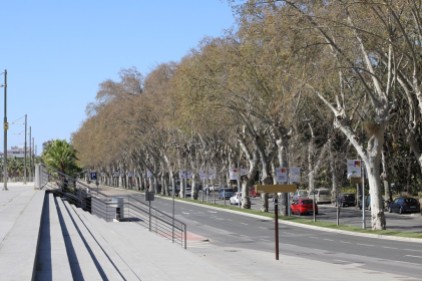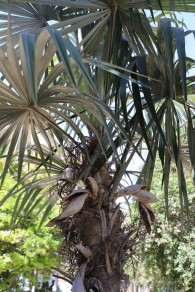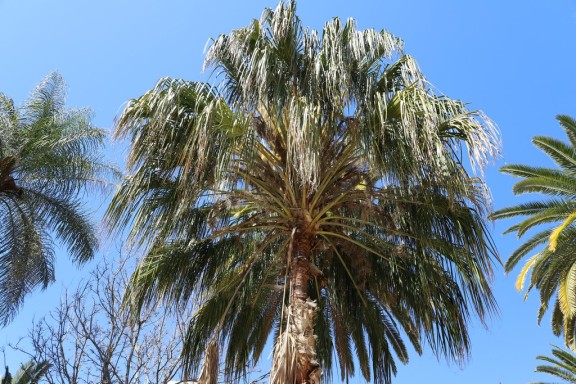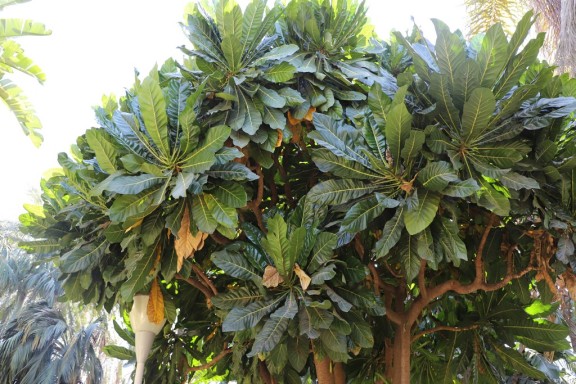I was recently given the wonderful opportunity to co-lead botanical tours in Andalucia, Southern Spain, with the wildlife holidays company NatureTrek. More about that later…
As I was getting to Malaga earlier than the group, I had a day to explore the city, and of course to discover its botanical heritage.

After a misty arrival into Malaga Airport, my first stop was the Parque de Málaga, a 33 hectares urban park in the heart of the old town.
The origin of the park dates back to the end of the 19th century, when tourism was starting to develop in the city of Malaga. A large-scale redevelopment of the harbour was decided, with the aim of making the seafront more attractive to visitors, and of providing the growing local population with urban green space. A large strip of land, on which the park sits, was reclaimed from the sea from 1896 onwards. Of course, the warm and sheltered climate of Malaga offered an ideal setting for a botanical garden showcasing a wide range of tropical, subtropical and Mediterranean plants.
An early view of the park’s plantings showing the Fuente de las Tres Gracias (Fountain of the Three Graces), and a view today with mature plane trees, taken from that same fountain:
Although the park was redeveloped and renovated several times during the 20th century, it still features many mature specimens of trees and shrubs. Its palm collection is one of the most impressive I have seen in cultivation. It includes species from all around the world, from the Australian foxtail palm Wodyetia bifurcata, to the rare and spectacular blue-leaved palm from Madagascar Bismarckia nobilis; the Cretan date palm Phoenix theophrasti or the Californian Palma Negra, Brahea brandegeei (hover your cursor on the images for names). A full species list is available on this excellent website if anyone is interested.
While walking around the park, I did notice several warning signs, asking visitors not to come under the trees as these had been treated. “El Picudo Rojo”, the Red Palm Weevil or Rhynchophorus ferrugineus is a serious threat to palm trees in Mediterranean countries, attacking a wide range of species, including the popular Canary Island Palm, Phoenix canariensis. While the beetle can fly long distances, the main damage is done by its larvae, which burrow inside the palm stems and eat plant tissue, leading to the collapse and the death of the palm trees. Present on the Southern Spain coast since 1994, it has led to changes in landscapes.


Of course, the Parque de Malaga isn’t only about palm trees. There are trees from the five continents, from conifers (Canary Island pine, Pinus canariensis and Barbary thuya, Tetraclinis articulata), to Australian silky oaks (in fact a protea, ), South American frangipani (Plumeria), African coral trees (Erythrina) and New Caledonian aralias (Meryta denhamii). Not all plants appear to have enjoyed the dry winter and spring in Malaga. Wet-loving Alocasia for example were looking rather poorly…
Among the series of small, romantic gardens that run through the parks, there’s a collection of fountains and statues waiting to be discovered. This is my favourite, an eagle with spread wings dedicated to a local poet, Salvador Rueda. The statue is seen through the pink flowers of a silk floss tree, Ceiba speciosa.

A stroll into town reveals historic palm avenues, heavenly scented streets filled with citrus trees, and delicate Jacaranda contrasting with modern buildings.
As the sun was setting down, I headed to a hill just above the city centre, which offers great views of Malaga.
This also gave me the opportunity for some last minute botanising, as a preview of the two weeks to come. A couple of rather poor pictures (taken after sunset with no flash): the curious sausage-shaped fruit of Andalusian Dutchman’s pipe, Aristolochia baetica; Coronilla glauca, the pretty Morocco Knapweed (Volutaria muricata); white asparagus (Asparagus albus), and a dainty campion (Silene secundiflora).
Stay tuned for a taste of Andalucian national parks, next 🙂


































Good memories of 2018. Thanks for sharing.
I also used this link to know the species present at the Parque de Malaga. https://waste.ideal.es/parquedemalaga.htm